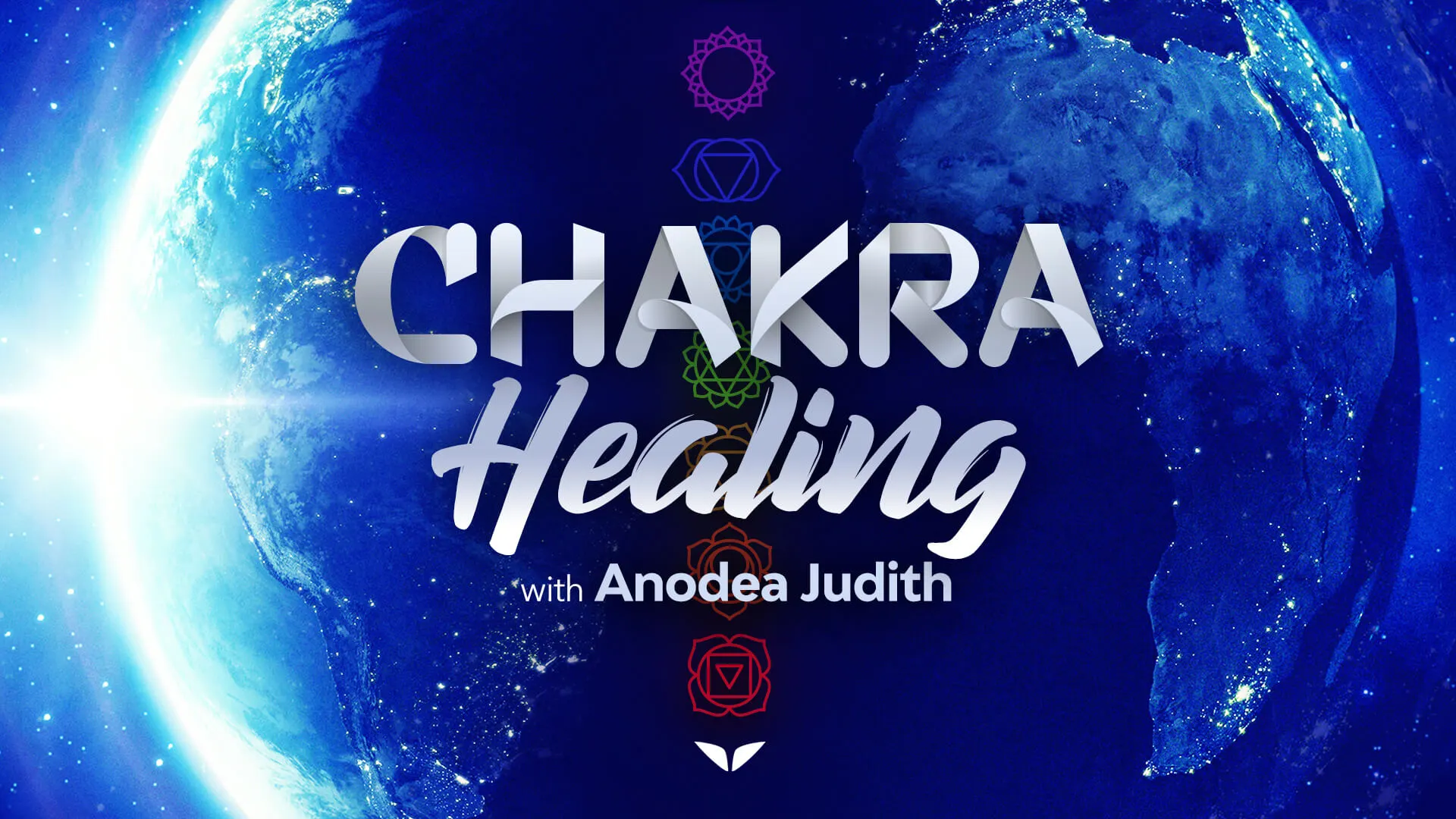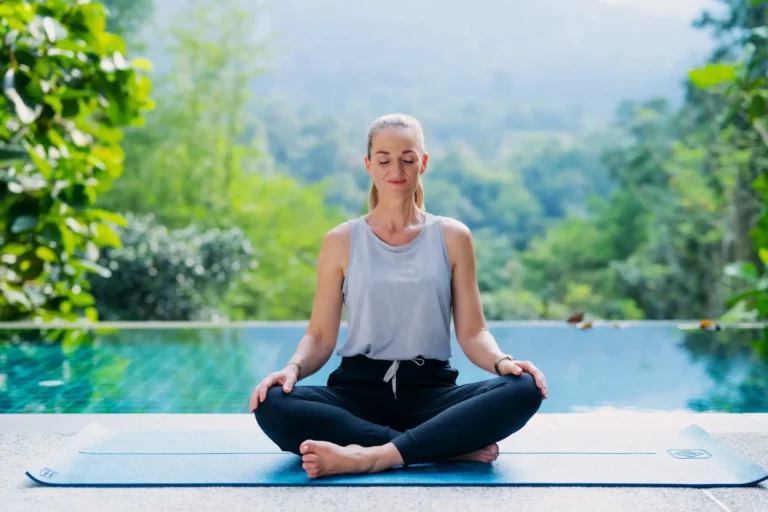Every great awakening begins with a small gesture.
For the Buddha, the dhyāna mudra was it: hands resting in the lap, thumbs touching, spine still enough to reverberate with universal wisdom.
The proverbial “under the Bodhi tree” moment, if you will.
Centuries later, this mudra invites you into the same space—in the rush before work, between back-to-back calls, or in those late nights when your mind just won’t quit it.
What is dhyāna mudra?
The “dhyāna mudra” meaning, in a nutshell, is “seal of meditation.” In Sanskrit, dhyāna translates to “meditative absorption,” which is a state where awareness turns inward and merges with pure presence. And it’s one of the most sacred mudras, or hand gestures, in Buddhism.
Simple, symmetrical, and deliberate, this hand gesture set out to balance duality in various aspects of life. Chakra healing expert Anodea Judith says it creates powerful mind-body effects.
In yogic philosophy, this mudra represents harmony in the body’s central energy channel, the sushumna nadi, which is said to connect all seven of your chakras (energy centers). It is, Anodea says, “the central current where you become both grounded and uplifted” when balanced.
Sure, it sounds too simple and too good to be true. But according to Deborah King, a spiritual teacher and author of the New York Times bestseller Be Your Own Shaman, the mudra can work wonders. And it’s a perspective shared in many energy healing traditions, which see the body as a subtle field of forces that respond to conscious intent.
So, this mudra can be all you need to remember that stillness itself is an act of power, in a world fixated on constant motion.
How to do the dhyāna mudra step by step
Bring to mind images of the Buddha sitting under the Bodhi tree, in lotus position, with his eyes half-closed? Peer closer at his hands, and you’ll see the dhyāna mudra in its full splendor:
Both hands resting on his lap, palms open to the sky, and the softest, subtlest triangle finishing it.
To do it yourself, you:
- Get into the lotus position.
- Rest both hands on your lap with palms facing up.
- Place the right hand over the left so the fingers line up.
- Lightly touch your thumbs together to form a soft triangle.
- Sit tall, relax your shoulders, and breathe mindfully through your nose.
- Hold for three to 10 minutes (or longer) with a soft gaze or closed eyes.
Mechanically speaking, the gesture’s as easy as “one, two, three.” Yep, three moves and you’re there. But you’d need to put in the work at the energetic level with a light touch, symmetrical hand positioning, a relaxed jaw, and an unclenched belly.
If your back tightens, it’s only a matter of time before your focus slips out of position. And if the thumbs press too hard, you risk agitating your mind with the resulting ache.
When in doubt, aim for simplicity. Ergo, the less you do, the more the mudra itself “does” the work for you.
Dhyāna mudra: symbolism and elements
You can think of the dhyāna mudra as a kind of sacred geometry symbol, but embodied. Each element that makes up its whole form acts as a subtle code for body-mind-soul harmony.
Together, these parts create a map for how energy moves, balances, and gets you back to a state of stillness. Here’s how:
1. The triangle of the thumbs
In Buddhism, the mudra reflects the Three Jewels concept:
- The Buddha, who is a living example of human awakening,
- The Dharma, the teachings and practices that show the way, and
- The Sangha, a community of kindred spirits, if you will, that keeps you steady.
In other words, you have a model, a map, and a circle… the three anchors that make inner work practical and sustainable.
2. The spine: the meeting of two energy currents
In chakra philosophy, this mudra symbolizes the convergence of two vital streams that flow along the spine. One is the ascending current of awareness, and the other is the descending current of grace.
The first moves upward, from the root of the body to the crown of the head, to “carry” your attention, focus, and consciousness toward expansion. The second moves downward, bringing insight, intuition, and spiritual nourishment back into the body.
You need both for self-healing. Awareness rises so you can perceive truth as it is, and grace descends so you can live it out. Integrate both, and you’ll no longer feel so out of focus.
Instead of scattering outward, it circulates through your centers, creating the mind-body equilibrium that helps you feel steady, clear, and deeply present.
3. Open palms: receptivity for universal wisdom
The open palms might look simple, but they carry quiet intelligence. When you turn them upward, you’re signaling to the body that it’s safe to let energy move freely again.
They’re why mudras like the dhyāna, Deborah explains, can “stimulate different areas of your body and aid in the flow of your energy, your prana.”
The Indian yoga master Swami Satyananda Saraswati, founder of the Bihar School of Yoga and one of the pioneers of modern yogic science, once described this position as an “attitude of receptivity.” He taught that when the palms face upward, the mind naturally opens up, and you begin to funnel energy inwards instead of outwards.
Vedic scholar and Ayurvedic teacher Dr. David Frawley, who’s known for bridging Eastern wisdom with Western understanding, adds another layer to this view. He explains that the palms are dense with pranic points, a.k.a., energy centers tinier than chakras that receive and conduct subtle currents throughout the body.
In this vein, open palms are the great symbol of receptivity. You might think of them as a reminder to stay open to subtle sensations, such as the rhythm of breath, warmth, and stillness that accompany meditation.

The benefits of practicing the dhyāna mudra
“When your breath and movement align, fear softens and the body remembers safety,” says Anodea in her Mindvalley program, Chakra Healing. It’s a simple line that captures what the dhyāna mudra hand opposition truly expresses: helping you return to your body.
And it achieves this through a range of subtle yet powerful effects, reflected in the numerous benefits it offers.
Mental and emotional benefits
When your hands rest evenly in your lap, the body gets the memo: “It’s safe to relax.” Then, cue the even breaths, softening of the shoulders, and mental clarity.
Researchers are beginning to understand why. One study found that maintaining the body in symmetrical postures, like with this mudra, helps stabilize attention and regulate emotions. As a result, you’ll experience less anxiety and fewer racing thoughts.
Another study shows that meditation practices combining breath, stillness, and specific postures (including this mudra) can activate the parasympathetic nervous system, your body’s rest-and-recovery mode. That shift, in turn, lowers cortisol, steadies the heart, and helps the body remember what calm feels like.
The message seems clear: practice this intentional gesture long enough and you’ll retrain your baseline state of mind.
Spiritual benefits
The dhyāna mudra develops mindfulness at its core. Sitting with the hands in this gesture draws awareness inward, allowing the mind to quiet and the body to follow. “When the mind is quiet and the body still,” says Anodea, “awareness expands into its natural state of spaciousness.”
Over time, that mindfulness expands beyond the meditation cushion, showing up in how you breathe, listen, and move through daily life.
The mudra also teaches resilience, which is what spiritual growth is about. “Spiritual awakening isn’t about leaving the world,” Anodea adds. “It’s about seeing the world through a wider lens.”.
This is where the mudra can take on a deeper meaning, as it represents the unity of three essential life aspects in Buddhism: nirvana (bliss), samadhi (presence), and samsara (the cycle of existence).
And with practice, this gesture eventually becomes a symbol of divine unity, making the ups and downs of life more meaningful. Like Anodea points out, “Everything—bliss, presence, even struggle—is part of the same divine dance.” In this realization, awakening becomes a daily reality to live in, rather than a distant ideal to aspire to.
Physical benefits
At first glance, the dhyāna mudra looks effortless. But here’s the thing: while you’re holding it, there’s a lot more that goes on in your body as a result.
When your hands rest evenly in your lap, your posture naturally balances out. Your shoulders ease up, taking pressure off the neck and upper back. This, in turn, frees the diaphragm to move naturally, making each breath smoother and steadier.
With time, the body remembers this alignment and returns to it with less effort. Once you find that balance, you invite additional physical benefits.
Research on meditation postures suggests that even simple seated poses can improve circulation, enhance breathing, and lower blood pressure and resting pulse. What’s more, staying still in a symmetrical posture increases nervous system and heart-rate variability (a key marker of calm and resilience).
Bit by bit, your body learns that true stillness can hold you up quite like nothing else can.
How to practice the dhyāna mudra
You don’t always need to be in a perfect lotus pose to practice the dhyāna mudra. What matters is that you feel grounded and comfortable enough to stay still. You can sit cross-legged on the floor, on a cushion, or even on a chair with your feet flat and spine upright.
Once you’re settled, form the mudra, as prescribed earlier: right hand over left, palms open to the sky, thumbs lightly touching. Let your hands rest just below the navel, close to the solar plexus, the body’s energetic center of calm and confidence.
From there, the practice can unfold in many ways:
- During meditation. This is where it naturally belongs. The gesture draws energy inward and helps your mind settle into a deeper stillness.
- At the start or end of a yoga session. Use it to center yourself before you move, or to “seal” the practice afterward as your energy settles.
- Before sleep or rest. Placing your hands in this position while lying down or sitting quietly can help ease the body out of alert mode.
- Whenever you’re overwhelmed. Even a few minutes of practice can help ease emotional surges. When you pause and breathe mindfully in this position, your body may naturally shift towards calmness.
- After energy healing. As Deborah says, the hands are “gateways for prana.” Using this mudra after deep breathwork or energy practices helps the flow integrate through your system.
- During those in-between moments. Between meetings, after a challenging conversation, or before making a big decision, these transitional moments are invitations to return to yourself. And the dhyāna mudra? It can be a quiet way to make that shift.
Anodea often reminds her students that stillness is where the subtle realizations about yourself and your life begin to emerge. So, each time you return to this gesture, you give yourself the chance to be cognizant of your deepest truths.
Like she says in her program, “When we bring awareness into the body, we bridge heaven and earth within ourselves.”
Common mistakes when practicing the dhyāna mudra and how to avoid them
The dhyāna mudra takes practice to feel natural. Think of it as a gradual tuning process: your body learns, your awareness refines, and comfort grows with time.
- Poor posture. A rounded back or tense shoulders can restrict your breath and make maintaining stillness harder. Sit tall with a relaxed spine and an easy lift through the crown of your head.
- Forcing the hands. Heavy pressure in the thumbs or stiffness in the fingers interrupts the flow of calm. Keep your touch light and steady. The connection should feel natural, like two magnets softly meeting.
- Discomfort or tension. Pain in the knees, hips, or back is a cue to adjust your seat. Try using a cushion, a folded blanket, or a chair until your body can relax into the posture. Comfort supports focus more effectively than endurance ever could.
- Skipping consistency. Sporadic practice keeps the body guessing. A few minutes daily works better than a long session once in a while. The repetition helps your system remember the rhythm of calm.
- Rushing the practice. The dhyāna mudra unfolds in its own time. Move slowly, breathe deeply, and let the stillness settle at its own pace. As Anodea often says, “The slower you go, the more you can feel.”
Every minor correction you make, from loosening the hands to lengthening the breath to finding ease in your seat, is part of the practice itself. With intent, you’ll reap the rewards of this mudra over time, with earned effortlessness.
Integrating the dhyāna mudra into your meditation practice
Once you’ve learned the form, the next step is to live it.
The dhyāna mudra meditation transforms a simple hand gesture into a full-body reset… through synergy between your stillness and awareness. Think of it as the moment your body says, “I’m ready to listen.”
Here’s how to bring it into your daily practice:
- Set the scene. Find a spot that feels calm but alive, like a corner of your room, a quiet garden, or even your parked car before work. Give yourself permission to pause and simply be.
- Take your seat. Sit comfortably. Cross-legged, kneeling, or on a chair, it doesn’t matter… whatever supports your back and lets you breathe with ease.
- Form the mudra. Place your right hand over your left, palms facing up, thumbs gently touching. Rest them just below your navel.
- Drop in. Close your eyes. Feel your hands meeting. Let your attention gather in that soft triangle your thumbs make. Inhale through the nose; exhale slowly through the mouth.
- Follow the rhythm of your breath. As you inhale and exhale steadily, imagine a quiet pulse rising up your spine with every inhale and flowing back down with every exhale. That rhythm is your body syncing with its own energy.
- Stay curious. If thoughts wander in—work, dinner, that thing you said yesterday—see them, thank them, and come back to your breath. Each return is part of the practice.
- Seal the moment. After a few minutes, release your hands and take a deep breath. Notice how the air feels cooler, the space feels wider, and the silence is a little friendlier.
The beauty of the dhyāna mudra meditation? It’s endlessly portable. You can do it at sunrise before the world wakes, in the middle of your workday chaos, or under the stars when you’re too wired to sleep.
So the next time life pulls you in every direction, just pause and come back to it. Two hands, one breath… they’re all you need for calmness that feels infinite.
Jumpstart your dhyāna mudra practice with this quick meditation:
Awaken your spiritual superpower
The power to heal rises when you start tuning in to your own energy. Bodily tools, even ones as simple as the dhyāna mudra, can open the door. But that’s only the first step in a lifelong journey of aligning your body, mind, and soul.
That deeper journey unfolds in Anodea Judith’s Chakra Healing program on Mindvalley, a complete system designed to restore balance across your energy body and cultivate an effortless flow that carries into every part of your life.
You’ll explore how to:
- Recognize areas of emotional or energetic tension,
- Restore balance through the seven chakras using guided healing techniques,
- Build a daily practice that clears the mind and steadies the body, and
- Much more.
If you’d like to experience it firsthand, just sign up for a free Chakra Healing class with Anodea. It’s where you’ll get a glimpse of her most powerful methods and insights and feel how quickly energy begins to shift when awareness meets practice.
Thousands of Mindvalley members have shared how Anodea’s work helped them feel grounded, clear, and alive again.
Like Tammy Kjos, a wellbeing coach based in the United States, who shares:
After the first lesson. Each exercise helped me understand myself more deeply.
Her story illustrates what happens when you harness the power of energy work for self-empowerment. You learn to recognize your patterns, move what’s stuck, and let life flow again.
And the good news? Mindvalley is here every step of the way to keep that flow alive, with resources and a community of kindred spirits that move with you as you evolve.
Welcome in.







